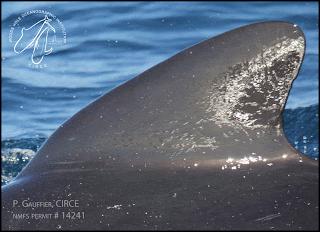The only thing worse than being stuck in the Bay of Algeciras waiting
for the fog to lift is discovering that in our rush to leave we mistook
salt for sugar in our iced coffee. The saving grace is that the bay is
completely filled with common dolphins.
The weather has been quite unpredictable over the last few days. We've gone out to sea, but fog or high wind has kept us from being able to work with the pilot whales. Instead, we head to the Bay of Algeciras, next to Gibraltar, where CIRCE is collecting photo-identification data on the dolphins who live there.
The weather has been quite unpredictable over the last few days. We've gone out to sea, but fog or high wind has kept us from being able to work with the pilot whales. Instead, we head to the Bay of Algeciras, next to Gibraltar, where CIRCE is collecting photo-identification data on the dolphins who live there.
 |
| Aixa Morata (front) and Mar Hernandez (rear) taking photo-ID pictures of a short-beaked common dolphin |
A fundamental issue in marine mammal research is being able to recognize
individual animals. This allows you to address basic issues such as
where and when animals have been sighted or what animals they regularly
associate with. This information also enables higher level studies of
population dynamics such as population size or birth and mortality
rates.
One way to identify individual animals is through photos of distinctive
features. We often recognize humans by photos of their faces, but
different species require different body parts. With humpbacks and
sperm-whales, we use tail flukes, and with pilot whales and dolphins,
nicks and notches on the dorsal fins and scars on the back allow us to
discriminate between animals.
 |
| A group of short-beaked common dolphins |
In the field, this means taking high-quality time-stamped photos of
dolphin and pilot whale dorsal fins and comparing them to a catalogue of
known individuals to identify the animals. Unlike in many parts of the
world, most of the pilot whales here are surprisingly well marked, but
others have very few markings and are extremely difficult to
distinguish. Over the last 13 years, CIRCE has built up a long-term
catalogue that enables identification of nearly all the resident and
immigrant pilot whales in the area.
 |
| A close up of a dorsal fin from a long-finned pilot whale allowing for photo identification |
This is why we are here. The information CIRCE has collected is crucial
for our studies of social dynamics. We rely on identifying animals in
the field so that we may select highly associated individuals -
individuals that are seen consistently together - for tagging. Toothed
whales are very capable vocal learners, and it is likely that they
change their calls when associating with specific individuals for long
time periods. The way animals interact within a social group is also
likely to differ depending on whether animals grew up together or not.
Thus, the long-term data on association patterns available here may help
us interpret datasets.
---
Nicholas Macfarlane and Frants Jensen

No comments:
Post a Comment